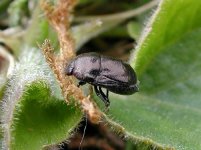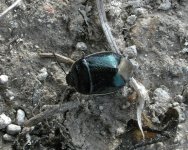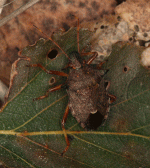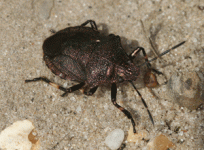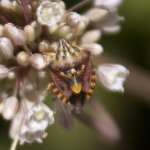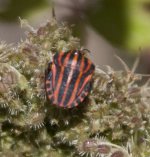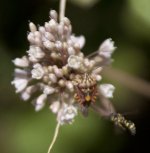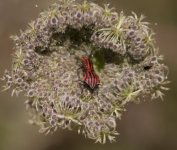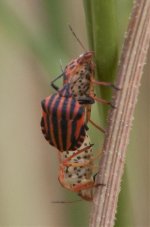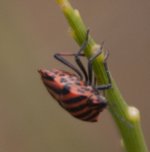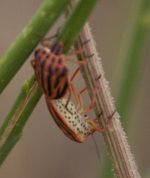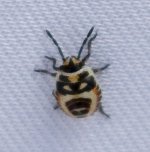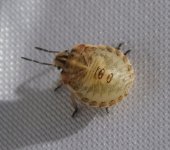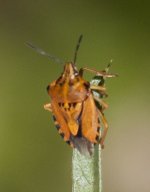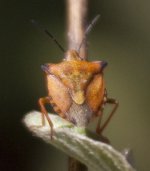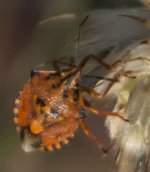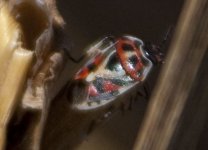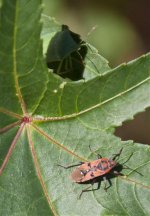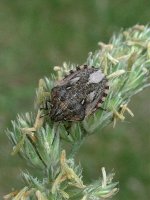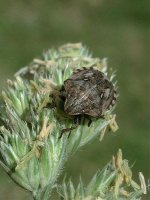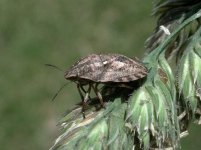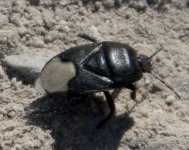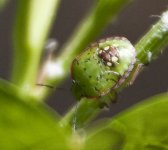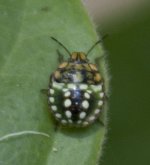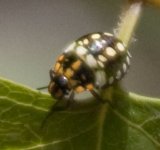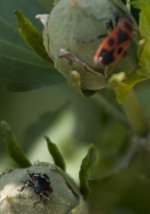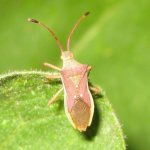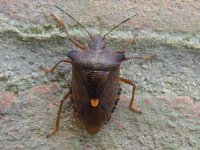-
Welcome to BirdForum, the internet's largest birding community with thousands of members from all over the world. The forums are dedicated to wild birds, birding, binoculars and equipment and all that goes with it.
Please register for an account to take part in the discussions in the forum, post your pictures in the gallery and more.
You are using an out of date browser. It may not display this or other websites correctly.
You should upgrade or use an alternative browser.
You should upgrade or use an alternative browser.
Shieldbugs. (5 Viewers)
- Thread starter Tammie
- Start date
More options
Who Replied?Stuart Read
Well-known member
Spent the day on Martin Down last week, I managed to find just 2 shieldbugs but they were both new for me; the tiny Negro Bug Thyreocoris scarabaeoides plus the rare Conthophorus impressus which I managed to find under the trailing stems of Bastard-toadflax, which itself was very hard to find as it wasn't in flower yet. A couple of photos attached.
Stuart
Stuart
Attachments
THE WANDERER
Well-known member
Shieldbugs at Chobham Common
Pics attached of two excellent predatory bugs seen yesterday on the Common.
Picromerus bidens - Spiny Shieldbug
Rhacognathus punctatus - Heath Shieldbug
Pics attached of two excellent predatory bugs seen yesterday on the Common.
Picromerus bidens - Spiny Shieldbug
Rhacognathus punctatus - Heath Shieldbug
Attachments
Last edited:
George Edwards
Nom de plume
Med Shieldbugs
Hi, from previous posts I have labelled these two, seen in the south of France on flower heads, as shieldbugs Codophila varia and Graphosoma italicum. Is that correct? Many thanks!
Also, do they have common names, English or French? Apologies for not wading through all previous 20 pages of this very informative thread again!
Hi, from previous posts I have labelled these two, seen in the south of France on flower heads, as shieldbugs Codophila varia and Graphosoma italicum. Is that correct? Many thanks!
Also, do they have common names, English or French? Apologies for not wading through all previous 20 pages of this very informative thread again!
Attachments
Last edited:
THE WANDERER
Well-known member
Nice bugs, I have heard the second one called the Milan Bug due to the colours resembling AC Milan FC!
George Edwards
Nom de plume
Thanks Wanderer - Milan it is then - easy to remember.
I saw a bunch more of them today, they like to live in that curled up flower.
And then I saw these three - which I took for an Italian menage-a-trois. However when I got home and looked at the pics on the computer, I realised the interloper was the only Milan Shieldbug (Graphosoma italicum / lineatum), and the other two are a different Graphosoma altogether - presumably semipunctatum.
They have dots near the head, and underneath have more, smaller dots on a paler background. Because I thought they were all AC Milan I didn't get a decent photo as I have loads already now. :-(
I saw a bunch more of them today, they like to live in that curled up flower.
And then I saw these three - which I took for an Italian menage-a-trois. However when I got home and looked at the pics on the computer, I realised the interloper was the only Milan Shieldbug (Graphosoma italicum / lineatum), and the other two are a different Graphosoma altogether - presumably semipunctatum.
They have dots near the head, and underneath have more, smaller dots on a paler background. Because I thought they were all AC Milan I didn't get a decent photo as I have loads already now. :-(
Attachments
George Edwards
Nom de plume
Wanderer, I've since found that the Milan Bug generally goes by the name of the Striped Shieldbug - possibly even easier to remember ;-) And Graphosoma lineatum seems to be the preferred species name.
http://www.gardensafari.net/english/picpages/graphosoma_lineatum.htm
Here are another two I saw - I think they are shieldbug nymphs or similar. The adults I saw in the vicinity were those above (G. lineatum and semipunctatum) plus the Dock Leaf Bug and Green Shieldbug.
The first looks a bit like a Burrowing Bug (Tritomegas sp.) on gardensafari's page.
Edit: on second thought Eurydema sp. (possibly E. oleracea) looks like a better fit:
http://www.commanster.eu/commanster/Insects/Bugs/Pentatomidae2.html
http://www.gardensafari.net/english/picpages/graphosoma_lineatum.htm
Here are another two I saw - I think they are shieldbug nymphs or similar. The adults I saw in the vicinity were those above (G. lineatum and semipunctatum) plus the Dock Leaf Bug and Green Shieldbug.
The first looks a bit like a Burrowing Bug (Tritomegas sp.) on gardensafari's page.
Edit: on second thought Eurydema sp. (possibly E. oleracea) looks like a better fit:
http://www.commanster.eu/commanster/Insects/Bugs/Pentatomidae2.html
Attachments
Last edited:
George Edwards
Nom de plume
Not sure if this thread is still alive but here are some more from today. The first three I will hazard a guess are Carpocoris mediterraneus (they were only about 50 yards away from the Med…), the fourth Eurydema ornata, and the last, coming round the corner, Nezara viridula, as the three white spots are just visible.
Attachments
Last edited:
Stuart Read
Well-known member
I found a number of eurygaster nymphs, 4th instar & younger, while sweeping tall sand dune grasses beside the coastal footpath in East Kent.
I retained a couple of nymphs, both 4th instars, to try & rear through, initially feeding them on the grasses they were swept from, then gave them a choice of locally growing species & they clearly favoured Cocksfoot of these.
They successfully matured into adults & I am extremely pleased to confirm they were both Eurygaster maura, the rarer of the two eurygaster species
Stuart
I retained a couple of nymphs, both 4th instars, to try & rear through, initially feeding them on the grasses they were swept from, then gave them a choice of locally growing species & they clearly favoured Cocksfoot of these.
They successfully matured into adults & I am extremely pleased to confirm they were both Eurygaster maura, the rarer of the two eurygaster species
Stuart
Attachments
Not sure if this thread is still alive but here are some more from today. The first three I will hazard a guess are Carpocoris mediterraneus (they were only about 50 yards away from the Med…), the fourth Eurydema ornata, and the last, coming round the corner, Nezara viridula, as the three white spots are just visible.
The last one isn't Nezara viridula, but don't know the species. It's from a different related family.
George Edwards
Nom de plume
The last one isn't Nezara viridula, but don't know the species. It's from a different related family.
Thanks Aeshna - can you say what it is that tells you that it's not Nezara viridula? I was going by a) all green b) 3 white spots and two (1 visible) black dots c) antennae red and yellow stripes at end, using this as a comparison:
http://www.britishbugs.org.uk/heteroptera/Pentatomidae/nezara_viridula.html
Last edited:
Stuart Read
Well-known member
The last one isn't Nezara viridula, but don't know the species. It's from a different related family.
The shieldbug in question is on the leaf behind the one with the rhopalid bug on, it is mainly in shadow & not that easy to see.
I would agree that it is Nezara viridula.
Stuart
George Edwards
Nom de plume
Oh I see what you mean now! Sorry, my fault, I took a pic (#5) http://www.birdforum.net/attachment.php?attachmentid=209014&d=1248631486 of the red Seed Bug (Spilostethus/Lygaeus pandurus of Lygaeidae family, I believe) and only noticed the well-camouflaged Shieldbug at home - should have mentioned that.
Last edited:
George Edwards
Nom de plume
3 more possible shieldbugs
Here are three I spotted at the weekend, nearby in Italy.
The first I think may be the Broad Shouldered Shieldbug - Cydnus aterrimus.
The second the Southern Green Shieldbug - Nezara viridula - in a nymph stage.
3, 4 and 5 are unknown, possibly not a shieldbug at all. Maybe three nymph stages (not the firebug but the insect below to the left). In the last pic I was taking a shot of the firebug and didn't see the insect behind. Pic 3 & 4 were ladybird sized.
Here are three I spotted at the weekend, nearby in Italy.
The first I think may be the Broad Shouldered Shieldbug - Cydnus aterrimus.
The second the Southern Green Shieldbug - Nezara viridula - in a nymph stage.
3, 4 and 5 are unknown, possibly not a shieldbug at all. Maybe three nymph stages (not the firebug but the insect below to the left). In the last pic I was taking a shot of the firebug and didn't see the insect behind. Pic 3 & 4 were ladybird sized.
Attachments
Last edited:
steve covey
Jack of all Orders - Master of None
Here are three I spotted at the weekend, nearby in Italy.
The first I think may be the Broad Shouldered Shieldbug - Cydnus aterrimus.
The second the Southern Green Shieldbug - Nezara viridula - in a nymph stage.
3, 4 and 5 are unknown, possibly not a shieldbug at all. Maybe three nymph stages (not the firebug but the insect below to the left). In the last pic I was taking a shot of the firebug and didn't see the insect behind. Pic 3 & 4 were ladybird sized.
Hi George,
pics 3, 4 & 5 are of 3rd instar Nezara viridula; they change quite a lot from one instar to the next! See here:
http://www.britishbugs.org.uk/heteroptera/Pentatomidae/nezara_viridula.html
Cheers,
Steve.
George Edwards
Nom de plume
Okaay! I feel like an idiot for not realising that after all the "research" I've done… Thanks Steve. They're very dinky looking nymphs  Can you confirm pic 1?
Can you confirm pic 1?
steve covey
Jack of all Orders - Master of None
No need - they're tricky little blighters at the best of times;o) More so on the continent as there's so many more of them [as there is of everything!!]Okaay! I feel like an idiot for not realising that after all the "research" I've done… Thanks Steve. They're very dinky looking nymphsCan you confirm pic 1?
I don't have any first hand experience of Cydnus aterrimus but your shot matches well with the illustrations in the guides I have. If you found it in a sandy area [which the background looks like!] and there were spurges in the vacinity, then I would say you certainly have that species.
DaveN
Derwent Valley Birder
Some cracking shots of bugs on here and this summer I've found myself getting into bugs of all kinds but shieldbugs just fascinate me. Could anyone confirm that this is a Forest Bug (Pentatoma rufipes)? Took the photo on the wall of my house yesterday. Cheers.
Attachments
Users who are viewing this thread
Total: 6 (members: 0, guests: 6)




